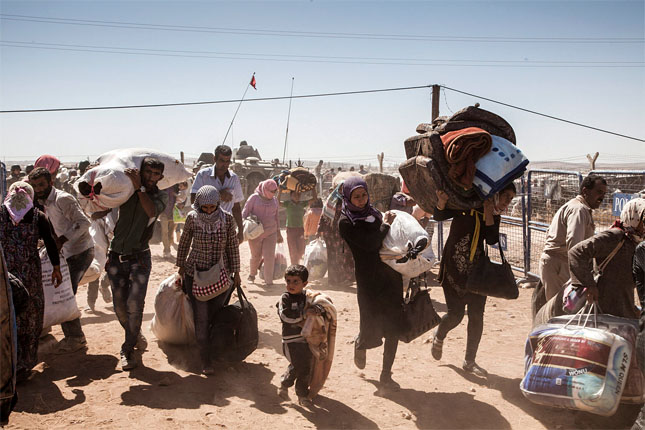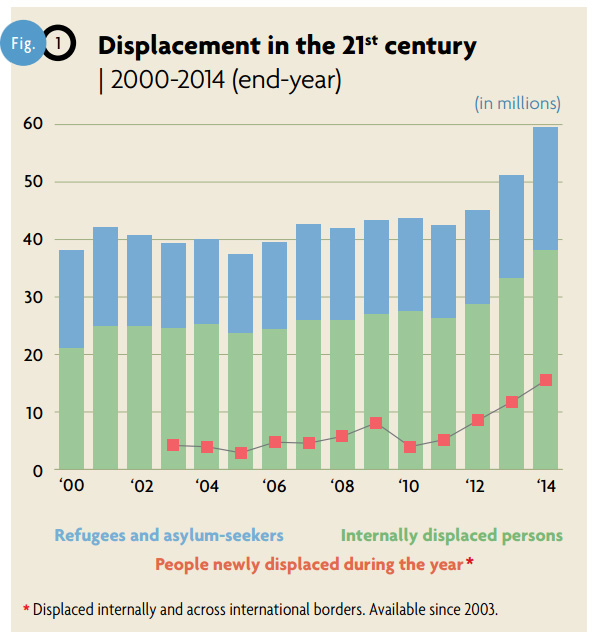-
Breaking the Fragility Trap: What Role for the World Bank?

Last month, the World Bank’s Fragility Forum in Washington, DC, brought together some 600 participants to discuss how to advance sustainable development in the context of increasing conflicts and violence. World Bank President Jim Yong Kim opened the forum by emphasizing that we are at a critical moment.
While the first two decades after the end of the Cold War saw a significant decline in the casualties from violent conflicts around the world, this trend has unfortunately reversed in recent years. Around 60 million people were forcibly displaced last year – the most since World War II – and these numbers are on the rise. Most displaced persons remain within their respective home countries, but more than 15 million are refugees.
As we see state fragility rise, various trends – climate change, population growth, increasing demand for food and water, environmental degradation – are putting pressure on states and societies. Where these pressures converge, they can drive fragility. Without appropriate responses, this will result in even more crises and even greater humanitarian needs.
 At the same time, the complexity of fragility-related challenges is increasing. In many cases, local and national-level conflicts have morphed into regional conflict systems that feed off and contribute to the degradation of social capital, functioning institutions, and a healthy environment. Geopolitics has come back with a vengeance. Attempts by regional and global powers to tilt the balance of power in various conflicts are intensifying violence and obstructing international efforts aimed at mediation.
At the same time, the complexity of fragility-related challenges is increasing. In many cases, local and national-level conflicts have morphed into regional conflict systems that feed off and contribute to the degradation of social capital, functioning institutions, and a healthy environment. Geopolitics has come back with a vengeance. Attempts by regional and global powers to tilt the balance of power in various conflicts are intensifying violence and obstructing international efforts aimed at mediation.Yet this growing complexity does not exonerate the international community. Trying to rise to the challenge, the participants of the World Bank Fragility Forum sought answers and ways to manage the rising number and complexity of crises around the world. One central theme was the institutional barriers faced by the World Bank and other development organizations and donors.
States of Fragility
The first barrier highlighted in sessions was the very label of “fragile state” and the negative connotations associated with it. Challenging narrow and prevailing concepts of fragility, Jim Yong Kim and many participants of the conference underlined the idea that fragility should be seen as a condition that any society can find itself in, and measured in degrees. More attention has to be paid to middle-income countries that are showing signs of fragility, he said.
There have been many innovations and changes by humanitarian and development organizations in response to the increase in fragility and complex crises. Yet too often organizations are still not willing to provide the necessary flexibility needed to adapt, focus too narrowly on static results frameworks, and do not spend enough resources on learning, monitoring, and evaluation to adjust.
Beyond the New Deal
The second barrier emphasized was siloed approaches – in particular the separation between humanitarian and development efforts. Senior officials at the opening panel all stressed the need for better cooperation between humanitarian and development actors, highlighting the bank’s commitment to reinforcing these efforts. However, that they felt the need to do so, in very strong language, implies that past efforts have not yet shown sufficient results.
Climate change was hardly mentioned during the forum’s opening panelBridging this divide will entail more than just shallow “mainstreaming,” the practice of paying lip service to the objectives of other policy communities with as few consequences for one’s own work as possible; it will mean changing incentive structures, in particular with respect to financing, to foster more joint and cross-sectoral planning and programming.
The New Deal, an “agreement between fragile and conflict-affected states, development partners, and civil society to improve the current development policy and practice in fragile and conflict-affected states” signed in 2011 epitomizes these aspirations. Yet as Sarah Cliffe from the Center of International Cooperation reported in a session devoted to the evaluation of the New Deal, its success has been mixed. The agreement created a normative coalition for change, she argued, and enhanced national ownership of many challenges, but has produced little success in improving aid.
While foreign assistance to fragile countries has increased overall, volatility remains a problem and the alignment of aid with peace- and state-building goals decreased between 2011 and 2014, Cliffe said. More generally, integrated programs and projects that bridge sectors – for example, by linking peacebuilding and climate change adaptation – are still few and far between.
It was striking that climate change was hardly mentioned during the forum’s opening panel (although both Jim Yong Kim and Jan Eliasson have previously emphasized the connection between climate change and fragility and conflict). With the World Bank now committing 28 percent of its investments to climate change projects and pledging to take global warming into account in all of them, there is an opportunity to leverage these funds to fight fragility and ensure that the mitigation and adaptation projects are conflict-sensitive.
The bank’s newly released Climate Change Action Plan, which commits the bank to producing a flagship report on the links between climate change and migration and conflict and to a reinforced focus on fragile states and communities, is a start. But the absence in the action plan of any reference to conflict-sensitivity in climate action shows policy integration is still more aspirational than a reality.
A Troubling Trend
The final institutional barrier emphasized was the focus on immediate threats, which prevents governments and organizations from addressing long-term risks such as climate change, economic development, and governance. Trading humanitarian needs off against structural spending is counterproductive because the money not spent on prevention will result in greater needs later on. What sounds like a no-brainer is anything but – prevention is still heavily underfunded.
The UN High-Level Panel on Humanitarian Financing’s report to the secretary-general highlights some chilling trends in disaster risk reduction (DRR) spending: “12 out of a group of 23 low-income countries received less than $10 million for DRR over 20 years while receiving $5.6 billion in disaster response.”
Other recent moves that come at the expense of efforts to address root causes of poverty, conflict, and forced displacement – such as Sweden’s decision to spend 30 percent of its overseas development budget on refugee reception and the internal re-allocation of UN funds towards the UN Refugee Agency for want of additional funding – bode ill and should not be replicated lest the exponential growth of humanitarian needs continues. Instead, the international community needs to be thinking about ways to reduce baseline needs.
Bank and Global Leadership Needed
Addressing fragility is not yet a priority for the international community, or the World Bank as a whole. But forum participants and bank leadership showed an understanding that achieving the post-2015 development agenda will be impossible if the international community and the multilateral system do not rise to this challenge. It is now crucial to mobilize broad political support and leadership.
The community needs to be thinking about ways to reduce baseline needsGovernments and donors must reduce demand for humanitarian assistance. That starts by recognizing, as President of the U.S. Institute of Peace Nancy Lindborg put it, that “we don’t have a refugee crisis but a fragility and conflict and violence crisis.” To avoid being overwhelmed in the future, the international community must go beyond treating the symptoms. It needs to reduce vulnerability and increase resilience today. As UN Deputy Secretary-General Jan Eliasson emphasized, this will involve “finally” giving priority to preventing conflict, and doing so early and collectively.
Integrating planning, financing, and implementation across policy sectors – by using, for example, climate adaptation measures to build peace and improve resilience to fragility too – also takes leadership. Without success stories that show how cross-sectoral cooperation yields significant benefits, it is hard to convince large institutions to allocate funding to integrated projects and programs. The World Bank could lead policy innovation in this area by embracing integrated policymaking and exploring best practices for setting financial incentives accordingly.
To address the fragility crisis, the World Bank’s leadership can, should, and needs to be supported by its shareholders. Governments around the world, particularly the major donors, can hold policymakers accountable to their commitments to better integrate and cooperate. Specifically, they could use the upcoming World Humanitarian Summit to ensure that long-term resilience to climate-fragility risks is firmly entrenched into the procedures of and the incentives for humanitarian actors.
Benjamin Pohl is a senior project manager at adelphi, a Berlin-based think tank on climate, environment and development, where he focuses on the interface between climate and resource governance and foreign, security, and development policy.
Lukas Rüttinger is a senior project manager at adelphi where he focuses on the links between environmental change and conflict. He has worked on the security implications of climate change for the UN, the OSCE, the European Commission, the European External Action Service, the German Foreign Ministry, and the G7.
Sources: Center on International Cooperation, The Guardian, Human Security Research Group, International Institute for Strategic Studies, Swedish International Development Cooperation Agency, UN High Commission on Refugees, UN High-Level Panel on Humanitarian Financing, World Bank.
Photo Credit: Kurdish refugees cross into Turkey from Syria, September 2014, courtesy of I. Prickett/UNHCR. Chart: UNHCR.
 A Publication of the Stimson Center.
A Publication of the Stimson Center.







